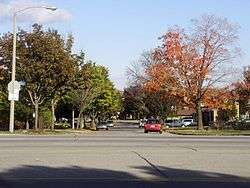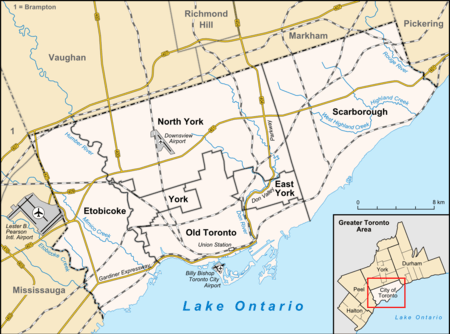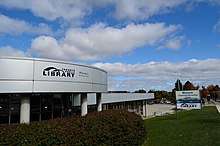Malvern, Toronto
Malvern is a neighbourhood in the city of Toronto, Ontario, Canada, with a population of 44,315.[2] It is located in the northeast corner of the city.
Malvern | |
|---|---|
Neighbourhood | |
 Looking across Markham Road | |
 Malvern Location of Malvern within Toronto | |
| Coordinates: 43°48′42″N 79°13′52″W[1] | |
| Country | Canada |
| Province | Ontario |
| City | Toronto |
| Community | Scarborough |
| Established | 1856 (Postal village) |
| Changed Municipality | 1998 Toronto from Scarborough |
| Government | |
| • MP | Gary Anandasangaree (L) Shaun Chen (L) |
| • MPP | Raymond Cho (C) |
| • Councillor | Neethan Shan |
There are over 60 different cultures represented in Malvern, with the most dominant ethnic groups being Caribbean Canadians (mostly Jamaican, Trinidadian, and Guyanese) and South Asian Canadians (mostly Sri Lankan Tamil, Indian and Pakistani). The neighbourhood has the highest concentration of young people in Canada.[3]
History
The history of Malvern began in 1856, when the Malvern Post Office was opened in David Brown's general store, which stood at the south-east corner of Finch Avenue and Markham Road. This post office was named after a resort town in England. A year after the post office was opened, Senator David Reesor — formerly of Markham Village — began selling "Village Lots" in Malvern. Reesor trumpeted Malvern as the future "Capital of Scarborough," anticipating that the Grand Trunk Railway would extend a branch line through here. Unfortunately, when the Grand Trunk Railway began service to this area in 1871, it bypassed Malvern in favour of the neighbouring village of Agincourt. The village centre and post office had by that time moved south to the corner of today's Sheppard Avenue and Markham Road.[4] The Malvern Primitive Methodist Church on the east side of Markham Road north of Sheppard disappeared in the 1970s, but the graves remain today in the care of the Toronto United Church Council.
While Malvern never did become a prosperous railway centre, it flourished as a farming community for over one hundred years. In the late 1950s, the Canada Mortgage and Housing Corporation expropriated Malvern's farms to build a "model community" of affordable homes. The first residents of this modern day Malvern community moved into their homes in 1972.
The Malvern community has attempted to improve following Project Impact, in which hundreds of police officers from the Greater Toronto Area cracked down on known associates of the "Malvern Crew" street gang, in early morning raids across the city on May 12, 2004. During the raids, 71 warrants were executed resulting in the arrest of 65 people.[5] Further raids, and the implementation of Project Pathfinder would result in arrests of the Malvern Crew's rival gang, the "Galloway Boys", in West Hill.

In the early 21st century, the area saw public investment in the community, including a major renovation of the Malvern Branch of the Toronto Public Library, the construction of new housing developments, the opening of a new park in 2004, and the opening of the Nike Malvern Sports Complex in 2006. The Toronto Zoo, the Rouge River, and the Rouge Valley Park are also located in the vicinity of Malvern, as was Mammoth Hall, a wooden structure that was once a municipal office, meeting hall and curling rink. Also, the Malvern Community Coalition serves as an active incorporated, non-profit, grassroots community organization which exists to promote and enhance the Malvern Community by engaging, empowering, and connecting community, organizations and institutions.[6]
Education
Two public school boards operate schools in Malvern, the separate Toronto Catholic District School Board (TCDSB), and the secular Toronto District School Board (TDSB).
Both TCDSB, and TDSB operate one public secondary school in the neighbourhood. TCDSB operates St. Mother Teresa Catholic Academy, while TDSB operates Lester B. Pearson Collegiate Institute. In addition to secondary schools, both school boards operate several public elementary schools in the Malvern. They include:
- Alexander Stirling Public School (TDSB)
- Berner Trail Junior Public School (TDSB)
- Burrows Hall Junior Public School (TDSB)
- Dr. Marion Hilliard Senior Public School (TDSB)
- Emily Carr Public School (TDSB)
- Fleming Public School (TDSB)
- Grey Owl Junior Public School (TDSB)
- Heritage Park Public School (TDSB)
- Lucy Maud Montgomery Public School (TDSB)
- Malvern Junior Public School (TDSB)
- Mary Shadd Public School (TDSB)
- Sacred Heart Catholic School (TCDSB)
- St. Barnabas Catholic School (TCDSB)
- St. Bede Catholic School (TCDSB)
- St. Columba Catholic School (TCDSB)
- St. Florence Catholic School (TCDSB)
- St. Gabriel Lalemant Catholic School (TCDSB)
- Tom Longboat Junior Public School (TDSB)
The French-first language public secular school board, Conseil scolaire Viamonde, and it separate counterpart, Conseil scolaire catholique MonAvenir also offer schooling to applicable residents of Morningside, although they do not operate a school in the neighbourhood, with CSCM/CSV students attending schools situated in other neighbourhoods in Toronto.
The former S.S. #3 Schoolhouse, serving the Malvern area, built in 1872 stood on 1-acre (4,000 m2) of land purchased from George Pearson,[4] is still standing today at 5810 Finch Avenue East. The building is presently used by a private school, Whitefield Christian Academy.
Transportation

Several major roadways are located in Malvern. The neighbourhood is bounded to the south by Highway 401 is a major east-west controlled access highway that passes through Greater Toronto. Several other major roadways include Morningside Avenue, and Sheppard Avenue. Located on Sewells Road, the Sewells Road Bridge is a bridge over the Rouge River, in the northeast of Malvern.
Public transit
Malvern is served by several Toronto Transit Commission (TTC) bus routes (39 Finch East, 85 Sheppard East, 102 Markham Rd, 116 Morningside, 131 Nugget, 132 Milner, 133 Neilson, 134 Progress, 902 Markham Rd Express, 939C Finch Express, and 985B Sheppard East Express). In the 1980s, there was a plan to bring rapid transit to Malvern by extending the Scarborough line, but lack of government funding prevented any extension of the line. In August 2006, city councillors representing Scarborough rallied for the expansion of the Scarborough line, or its possible light rail replacement, to the Malvern community.
Scarborough line extension to Malvern
The TTC is currently carrying assessing extending the RT from McCowan to Malvern Town Centre.[7] They have also made a motion that the current study should include the addition of a station where the existing line crosses Brimley Road.[8]
In 2006, a study was completed on the prospects of this line.[9] It recommended upgrading the line to handle larger ART Mark II vehicles, at a cost of $360 million (2006 dollars). Extending the Bloor–Danforth line (either along the current Scarborough RT route, or along a different alignment directly to Scarborough Centre) was not considered cost-effective or justifiable.
On June 15, 2007, the Ontario government had released MoveOntario 2020, a plan that would fund 52 different transit projects throughout Toronto and Hamilton for the cost of $17.5 billion, including the Scarborough RT extension to Sheppard Avenue, which would meet the proposed Sheppard East LRT line, also to be funded by MoveOntario 2020. Unfortunately, in a 2010 budget release, Ontario Premier Dalton McGuinty had chosen to postpone necessary funding for the project.
Scarborough Malvern LRT
The Scarborough Malvern LRT line, part of the TTC's Transit City plan, would run for 15 km, estimated to account for 14 million trips in 2021. The southern terminus of the line would be built at Kennedy Station at Kennedy Road and Eglinton Avenue, with a connection to the Bloor-Danforth subway, the Scarborough RT, and the Eglinton Crosstown LRT line. The whole line would be built within Scarborough. The line would run along Eglinton Avenue East until it reaches Kingston Road, then continues northeast until Morningside Avenue is reached, then continues north until Sheppard Avenue East, where it turns west, sharing the same tracks and stops as in the Sheppard East LRT line. Finally, the line turns north at Neilson Road, terminating at Malvern Town Centre.
Newly elected Rob Ford cancelled the Malvern LRT shortly after he came to office in 2010.[10] [11]
The Malvern LRT would cross the University of Toronto Scarborough Campus.[11] According to The Varsity, the paper for students at the University of Toronto, when students at the Scarborough campus were asked to contribute $30 million towards the construction of an Olympic class pool on their campus, which would first be used for competitions during the 2015 Pan American Games, they were promised two LRT lines would be brought to campus. The Varsity reported that the students had held up their part of the bargain and resented that the city dropped plans to build the LRT lines.
Economy
Although Scarborough Town Centre is a short drive away, Malvern Town Centre provides some retail options and amenities to local residents. Built in the late 1980s, the mall's primary tenant are Freshland Supermarket, an Asian grocery store; Planet Fitness, and Labels, a discount clothing store.
Demographics
In 2016, the Malvern neighbourhood was home to 43,794 residents.[12] 51% of the population speak English as their first language, 12.5% speak Tamil, 6% speak Tagalog, 5% speak Urdu, 3.9% speak Cantonese and 3.6% speak Gujarati.
Major ethnic populations (2016):
- 39.9% South Asian; 21.3% Indian, 16.3% Sri Lankan or Tamil, 3.2% Pakistani
- 18.9% Black; 9.3% Jamaican, 3.3% Guyanese
- 11% Filipino
- 9.5% White; 4.6% British
- 7.5% Chinese
Climate
| Climate data for Malvern, Toronto (1971-2000 Normals) | |||||||||||||
|---|---|---|---|---|---|---|---|---|---|---|---|---|---|
| Month | Jan | Feb | Mar | Apr | May | Jun | Jul | Aug | Sep | Oct | Nov | Dec | Year |
| Average high °C (°F) | −2.6 (27.3) |
−1.6 (29.1) |
3.6 (38.5) |
11.1 (52.0) |
18.4 (65.1) |
23.1 (73.6) |
26.5 (79.7) |
25.1 (77.2) |
20.1 (68.2) |
13 (55) |
6.7 (44.1) |
0.3 (32.5) |
12.0 (53.5) |
| Average low °C (°F) | −9.6 (14.7) |
−8.7 (16.3) |
−4.3 (24.3) |
2.1 (35.8) |
8.2 (46.8) |
12.8 (55.0) |
16.4 (61.5) |
15.5 (59.9) |
11.1 (52.0) |
4.9 (40.8) |
0.2 (32.4) |
−6.2 (20.8) |
3.5 (38.4) |
| Average precipitation mm (inches) | 56.1 (2.21) |
49.8 (1.96) |
65.6 (2.58) |
78 (3.1) |
80.8 (3.18) |
72.4 (2.85) |
72.1 (2.84) |
92 (3.6) |
93.5 (3.68) |
72.4 (2.85) |
88.3 (3.48) |
78.5 (3.09) |
899.5 (35.42) |
| Source: Environment Canada | |||||||||||||
Notable residents
- Glenn Lewis, R&B musician
- Lilly Singh, YouTuber and author, known by her username IISuperwomanII
References
- "Malvern". Geographical Names Data Base. Natural Resources Canada. Retrieved 2010-07-15.
- Malvern (132) - Social Profile #1 - Neighbourhoods - Age & Gender City of Toronto (2007). Retrieved on 2009-01-08.
- CANOE - The Toronto Sun CareerConnection - Youth Force
- "Township of Scarboro" (JPG). Canadian County Atlas Project. McGill University. 2001. Retrieved 2010-07-15.

- "Toronto police arrest 65 alleged gang members". CBC.ca. 13 May 2004. Retrieved 8 February 2011.
- MCC - What's Up in Malvern Archived 2007-10-08 at the Wayback Machine
- "Proposed Extension of the Scarborough Rapid Transit (SRT)". Archived from the original on 2012-10-06. Retrieved 2008-03-30.
- "TTC Minutes — February 27, 2008" (PDF). Retrieved 2008-03-30.
- "Scarborough RT Strategic Plan – Study Report — Final Report — August 2006" (PDF). Retrieved 2008-03-30.
-
"Mayor Rob Ford: "Transit City is over"". Toronto Life. 2010-12-01. Archived from the original on 2010-12-04. Retrieved 2014-03-17.
Rob Ford’s first few hours as mayor sure have been busy. As the dailies are reporting, Ford met with TTC chief general manager Gary Webster at seven this morning to let him know that Transit City, and its attendant "war on the car," were kaput. "I just wanted to make it quite clear that he understood that Transit City’s over and the war on the car is over, and all new subway expansion is going underground," Ford said, according to the Sun. "And that’s pretty well it."
-
Alessandra Harkness; Gabriela Ansari-Correa; Marcus Tutert (2014-03-17). "Questions remain on LRT lines through Scarborough: UTSC administration hopeful that issue will be resolved after municipal elections". The Varsity. Archived from the original on 2014-03-17.
UTSC students held a campus-wide vote on whether to contribute a portion of the cost of the Olympic-sized pool for the Pan Am Games. Although not a direct LRT vote, students thought that building for Pan Am would allow for the construction of the LRT. This resulted in a commitment from students to contribute $30 million towards the building of the Pan Am/Parapan Am Games facility, which are being built on UTSC property. According to Arale, the main reason for the contribution was to get the two LRT lines to run through campus. Students have held to their commitment and blame Toronto city councillors and administration for not holding up their end of the deal.
- "Malvern neighbourhood profile" (PDF). City of Toronto. Retrieved 2018-11-21.
External links
| Wikimedia Commons has media related to Malvern, Toronto. |